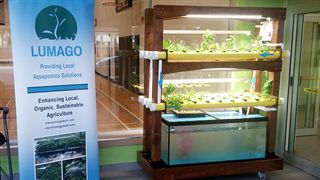
Until mid-February, Oakville Christian School in Oakville, Ontario, will host an aquaponics system, a self-sustaining ecosystem that uses bacteria to convert fish waste into a form of nitrogen that plants use to grow. The plants remove the nitrogen from the water, and the clean water is returned to the fish tank.
“We thought the aquaponics system would be a great way to introduce students to the concept of a sustainable ecosystem,” said Beth Wilson, the school’s academic coordinator and grade 7/8 science teacher. “It also has many curriculum tie-ins: grade 7 studies ecosystems and interactions between organisms; grade 3 studies plants and can monitor plant growth; grade 1 studies plants as well as healthy eating and can use the herbs, swiss chard, and kale for cooking.”
Wilson explains aquaponics this way: “The system includes an aquarium with fish (Oakville’s contains tilapia, but other systems use other freshwater fish). A feeder releases pellets of food to the fish each day. Bacteria have been added to the aquarium that convert the ammonia in the fish waste into nitrates, which dissolve into the water. The nitrate-rich water is pumped into tubes that allow the water to pass through the roots of the plants. The plants are grown (without soil) in a medium for the purpose of seed germination and stability. The nitrates are fertilizer for the plants, which the plants use to build proteins. This removes the nitrates from the water, so clean water flows back into the fish tank. The system provides a healthy environment for both the plants and fish.”
The school is renting the system through Lumago, and the company set up the system at the school and gave presentations to the students about aquaponics. “Lumago provides the fish, fish food, and plants,” said Wilson. “They also come every month to fill up the fish feeder and make sure everything is functioning well.”
The system appeals to the students for other reasons as well. “Some parents have said that their children have to stop and say ‘Hello’ to the fish each morning and ‘Goodbye’ each afternoon,” said Wilson. “We recently had an event in the atrium space, and a group of students wanted to sit on the floor in front of the system to eat their snack instead of sitting on chairs, so that they could watch the fish.”
Aquaponics is currently being studied by educational institutions and government agencies for its potential use to provide food in areas with food shortages as well food for restaurants.